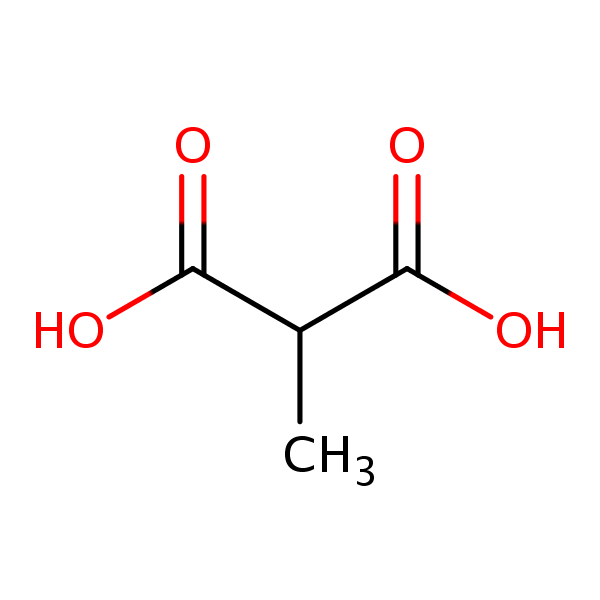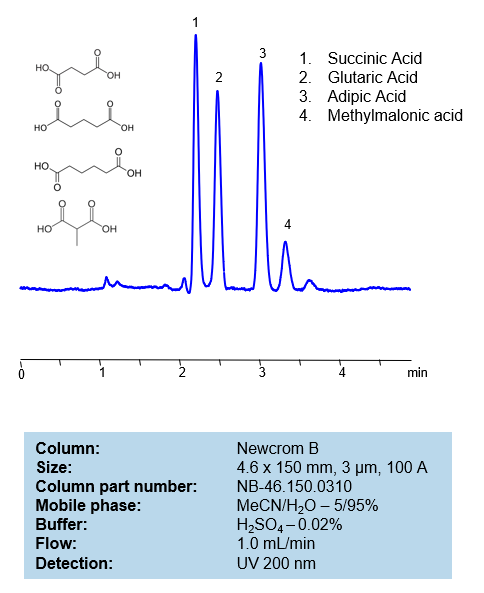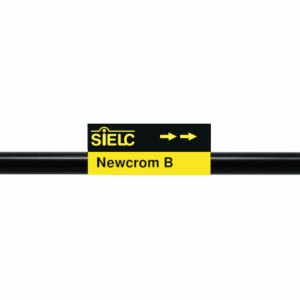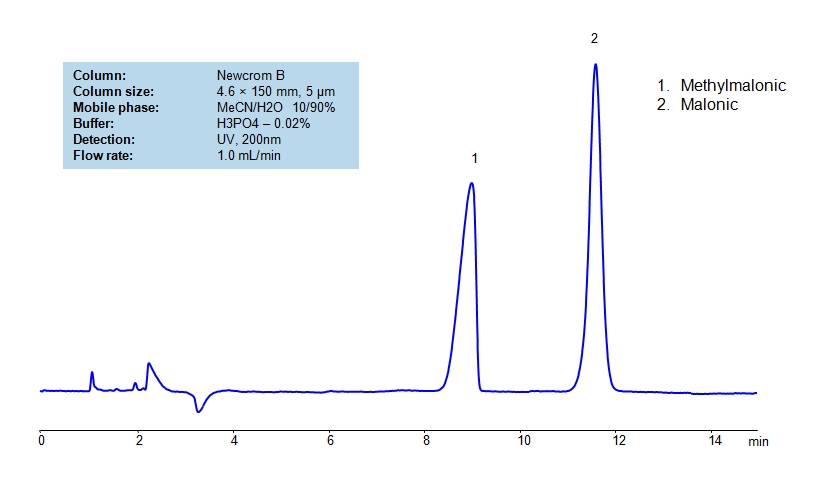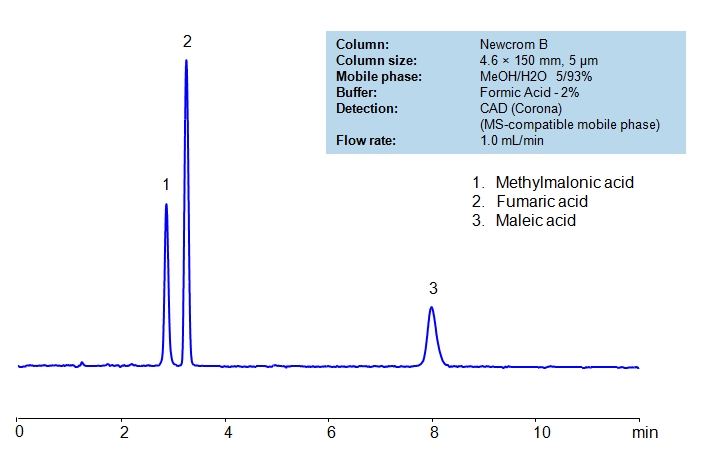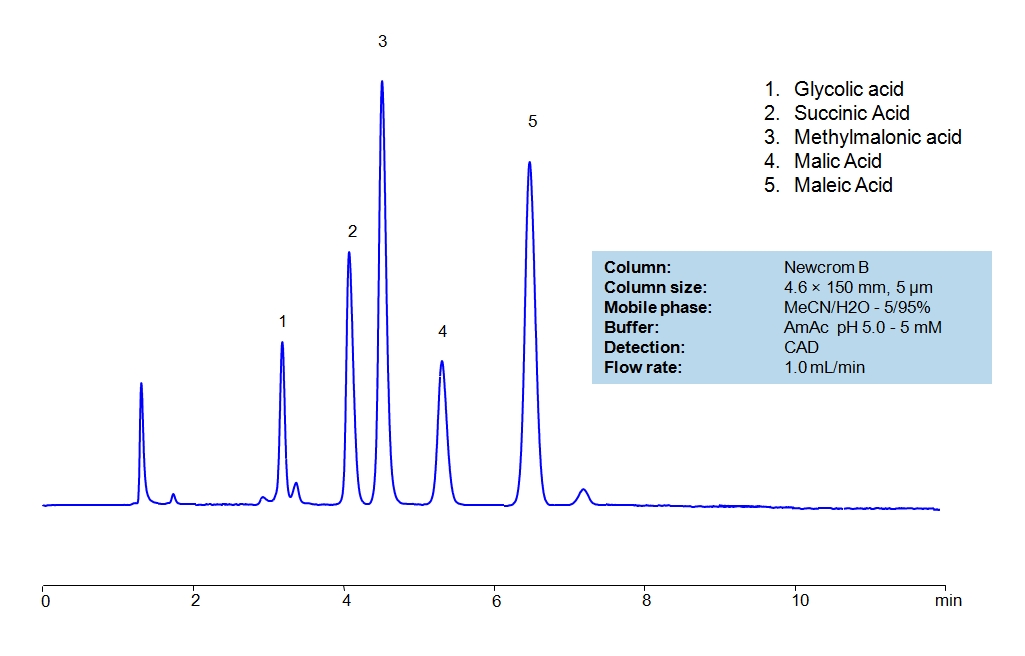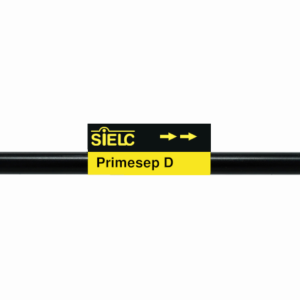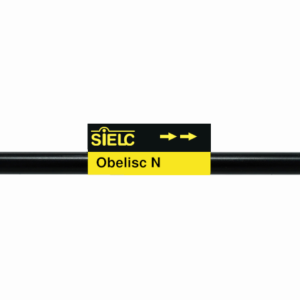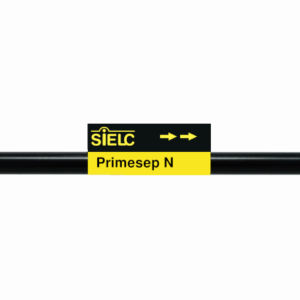| CAS Number | 516-05-2 |
|---|---|
| Molecular Formula | C4H6O4 |
| Molecular Weight | 118.088 |
| InChI Key | ZIYVHBGGAOATLY-UHFFFAOYSA-N |
| LogP | -0.367 |
| Synonyms |
|
Applications:
HPLC Method for Analysis of Dibasic Acids on Newcrom B Column
July 29, 2022
HPLC Method for Adipic Acid, Succinic Acid, Glutaric acid, Methylmalonic Acid on Newcrom B by SIELC Technologies
High Performance Liquid Chromatography (HPLC) Method for Analysis of Adipic Acid, Succinic Acid, Glutaric acid, Methylmalonic Acid.
Succinic acid is a key intermediary (in the form of its anion, succinate) in the electron transport chain, a process that is the key power source for our cells. It also has a few limited functions outside of the mitochondria. It has the chemical formula C4H6O4.
Glutaric acid is a common plasticizer precursor with the chemical formula C5H8O4. It is often used in the production of polyester polyols and polyamides. Interestingly, it is significantly more water soluble than either Succinic or Adipic acid.
Adipic acid, also known as hexanedioic acid, is a key precursor to nylon, and more than 2.5 billion kilograms are produced every year. In medicinal uses, it has been incorporated into controlled-release formulation as well as the polymeric coating of hydrophilic monolithic systems. It has the chemical formula C6H10O4.
Methylmalonic Acid is an organic acid with the chemical formula C4H6O4. It works as an intermediate in the breakdown of certain amino acids and fatty acids. Elevated levels of Methylmalonic acid can be a sign of a Vitamin B12 deficiency or Methylmalonic acidemia, which is a rare genetic disorder where the previously mentioned acid is not properly metabolized.
Adipic Acid, Succinic Acid, Glutaric acid, Methylmalonic Acid can be separated, retained, and analyzed on a mixed-mode Newcrom B column with a mobile phase consisting of water, Acetonitrile (MeCN), and Sulfuric acid (FA). This analytical method can be UV detected at 200 nm with high resolution and peak symmetry.
| Column | Newcrom B, 4.6 x 150 mm, 3 µm, 100 A, dual ended |
| Mobile Phase | MeCN/H2O -5/95% |
| Buffer | H2SO4 – 0.02% |
| Flow Rate | 1.0 ml/min |
| Detection | UV 200 nm |
| Class of Compounds | Acid, Hydrophilic |
| Analyzing Compounds | Adipic Acid, Succinic Acid, Glutaric acid, Methylmalonic Acid |
Application Column
Newcrom B
Column Diameter: 4.6 mm
Column Length: 150 mm
Particle Size: 3 µm
Pore Size: 100 A
Column options: dual ended
Glutaric acid
Methylmalonic Acid
Succinic Acid

HPLC Separation of Methylmalonic and Malonic Acid on Newcrom B Column
November 20, 2019
HPLC Method for Methylmalonic Acid, Malonic Acid on Newcrom B by SIELC Technologies
High Performance Liquid Chromatography (HPLC) Method for Analysis of Methylmalonic Acid, Malonic Acid .
Methylmalonic Acid is an organic acid with the chemical formula C4H6O4. It works as an intermediate in the breakdown of certain amino acids and fatty acids. Elevated levels of Methylmalonic avid can be a sign of a Vitamin B12 deficiency or Methylmalonic acidemia, which is a rare genetic disorder where the previously mentioned acid is not properly metabolized, leading to its accumulation.
Malonic Acid is an organic acid with the C3H4O4 chemical formula. It has a variety of uses from synthesis to preservatives. When it comes to synthesis, it is often used in industrial means. and especially dyes for natural fibers. Besides industrial use, in laboratory environments, it is used in preparation of tris-maleate, sodium maleate buffers, and maleate salts.
Methylmalonic Acid, Malonic Acid can be retained and analyzed using the Newcrom B stationary phase column. The analysis utilizes an isocratic method with a simple mobile phase consisting of water and acetonitrile (MeCN) with a triethanolamine buffer. Detection is performed using UV.
| Column | Newcrom B, 4.6 x 150 mm, 5 µm, 100 A, dual ended |
| Mobile Phase | MeCN/H2O – 10/90% |
| Buffer | H3PO4 – 0.02% |
| Flow Rate | 1.0 ml/min |
| Detection | UV 200nm |
| Class of Compounds | Acid, Hydrophilic, Polar |
| Analyzing Compounds | Methylmalonic Acid, Malonic Acid |
Application Column
Newcrom B
Column Diameter: 4.6 mm
Column Length: 150 mm
Particle Size: 5 µm
Pore Size: 100 A
Column options: dual ended
Methylmalonic Acid

HPLC Separation of Methylmalonic, Fumaric, Maleic acids on Newcrom B Column
October 28, 2019
HPLC Method for Fumaric Acid, Methylmalonic Acid, Maleic Acid on Newcrom B by SIELC Technologies
High Performance Liquid Chromatography (HPLC) Method for Analysis of Fumaric Acid, Methylmalonic Acid, Maleic Acid
Methylmalonic Acid is an organic acid with the chemical formula C4H6O4. It works as an intermediate in the breakdown of certain amino acids and fatty acids. Elevated levels of Methylmalonic acid can be a sign of a Vitamin B12 deficiency or Methylmalonic acidemia, which is a rare genetic disorder where the previously mentioned acid is not properly metabolized, leading to .
Malonic Acid is an organic acid with the C3H4O4 chemical formula. It has a variety of uses from synthesis to preservatives. When it comes to synthesis, it is often used in industrial means. and especially dyes for natural fibers. Besides industrial use, in laboratory environments, it is used in preparation of tris-maleate, sodium maleate buffers, and maleate salts.
Fumaric Acid, also known as trans-butenedioic acid, is an organic compound with C4H4O4 chemical formula. It is used across food, industrial, and medical industries. In food, is it often used as a preservative, pH regulator, and flavoring akin to citric acid. Industrially, it is used in making polyester resins, polyhydric alcohols, and more. Medically, it is used in denture cleaners and it’s derivatives are used in treating psoriasis.
Fumaric Acid, Methylmalonic Acid, Maleic Acid can be retained and analyzed using the Newcrom B stationary phase column. The analysis utilizes an isocratic method with a simple mobile phase consisting of water and acetonitrile (MeCN) with a formic acid buffer. Detection is performed using CAD.
| Column | Newcrom B, 4.6 x 150 mm, 5 µm, 100 A, dual ended |
| Mobile Phase | MeOH/H2O – 5/93% |
| Buffer | Formic Acid – 2% |
| Flow Rate | 1.0 ml/min |
| Detection | CAD (Corona) (MS-compatible mobile phase) |
| Class of Compounds | Acid, Hydrophilic, Ionizable |
| Analyzing Compounds | Fumaric Acid, Methylmalonic Acid, Maleic Acid |
Application Column
Newcrom B
Column Diameter: 4.6 mm
Column Length: 150 mm
Particle Size: 5 µm
Pore Size: 100 A
Column options: dual ended
Maleic Acid
Methylmalonic Acid

HPLC Separation of Small Organic Acids on Newcrom B Column
October 22, 2019
HPLC Method for Glycolic acid, Malic Acid, Maleic Acid, Methylmalonic Acid, Succinic Acid, Tartaric Acid, dl-Tartaric acid, Fumaric Acid, Citric Acid, Malonic Acid, Gluconic acid on Newcrom B by SIELC Technologies
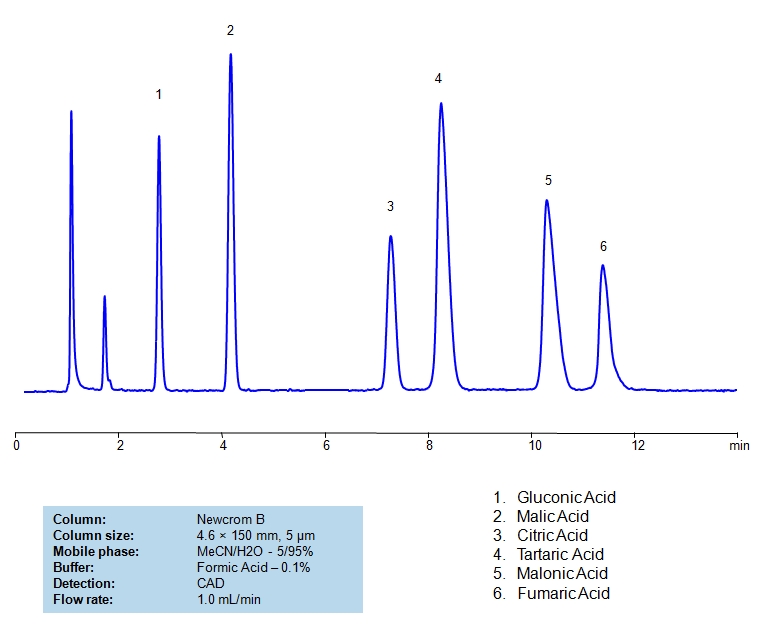
High Performance Liquid Chromatography (HPLC) Method for Analysis of Glycolic acid, Malic Acid, Maleic Acid, Methylmalonic Acid, Succinic Acid, Tartaric Acid, dl-Tartaric acid, Fumaric Acid, Citric Acid, Malonic Acid, Gluconic acid.
Gluconic Acid is an organic acid with the chemical formula C6H12O7. It is naturally found in fruits. Industrially, it is found in honey that is produced by fermenting starch. Typically, it is used in food, beverage, cosmetic, and skin care industries.
Malic Acid is an alpha hydroxy acid with the chemical formula C4H6O5. It is most commonly found in fruits and wines. It is sour, which is partially why it is often used as a food additive. Besides food, it is also used in skin-care as an exfoliant.
Citric Acid is a naturally occurring organic acid found in citrus fruits; it is also an intermediate in the citric acid cycle of aerobic organisms. It is used industrially as an acidity regulator, flavoring, detergent, and more than 2 million tons are produced annually. It’s chemical formula is C₆H₈O₇.
Tartaric Acid is an organic acid with the chemical formula C4H6O6. It is found in fruits like grapes and tamarinds and is a vital component of wine. It is also used in metal cleaning, as an antioxidant, and as an acidulant.
Malonic Acid is an organic compound with the chemical formula C3H4O4. It is also known as cis-butenedioic acid. It is a trans counterpart of fumaric acid. It has a variety of uses from dyeing natural fibers to oil and fat preservative, to synthesis of hydrogels.
Fumaric Acid, also known as trans-butenedioic acid, is an organic compound with C4H4O4 chemical formula. It is used across Food, industrial, and medical industries. In food, is it often used as a preservative, pH regulator, and flavoring akin to citric acid. Industrially, it is used in making polyester resins, polyhydric alcohols, and more. Medically, it is used in denture cleaners and it’s derivatives are used in treating psoriasis.
Glycolic acid, Malic Acid, Maleic Acid, Methylmalonic Acid, Succinic Acid, Tartaric Acid, dl-Tartaric acid, Fumaric Acid, Citric Acid, Malonic Acid, Gluconic acid can be retained and analyzed using the Newcrom B stationary phase column. The analysis utilizes an isocratic method with a simple mobile phase consisting of water and acetonitrile (MeCN). Detection is performed using CAD.
| Column | Newcrom B, 4.6 x 150 mm, 5 µm, 100 A, dual ended |
| Mobile Phase | MeCN/H2O – 5/95% |
| Buffer | AmAc pH 5.0, Formic Acid |
| Flow Rate | 1.0 ml/min |
| Detection | CAD (Corona) MS- compatible mobile phase |
| Class of Compounds | Acid, Hydrophilic, Ionizable |
| Analyzing Compounds | Glycolic acid, Malic Acid, Maleic Acid, Methylmalonic Acid, Succinic Acid, Tartaric Acid, dl-Tartaric acid, Fumaric Acid, Citric Acid, Malonic Acid, Gluconic acid |
Application Column
Newcrom B
Column Diameter: 4.6 mm
Column Length: 150 mm
Particle Size: 5 µm
Pore Size: 100 A
Column options: dual ended
Fumaric Acid
Gluconic acid
Glycolic acid
Maleic Acid
Malic Acid
Malonic Acid
Methylmalonic Acid
Succinic Acid
Tartaric Acid
dl-Tartaric acid

HPLC Separation of Succinic and Methylmalonic Acids
November 12, 2010

Organic and inorganic acids can be separated by reversed-phase anion-exchange Primesep D column. Succinic and methylmalonic acids were separated based on their hydrophobic and ionic properties. Method can be used for analysis of other acids by HPLC.
Application Column
Primesep D
The Primesep family of mixed-mode columns offers a wide variety of stationary phases, boasting unprecedented selectivity in the separation of a broad array of chemical compounds across multiple applications. Corresponding Primesep guard columns, available with all stationary phases, do not require holders. SIELC provides a method development service available to all customers. Inquire about our specially-tailored custom LC-phases for specific separations.
Select optionsOrganic Acids
Succinic Acid

HILIC Separation of Carboxylic Acids
August 22, 2008
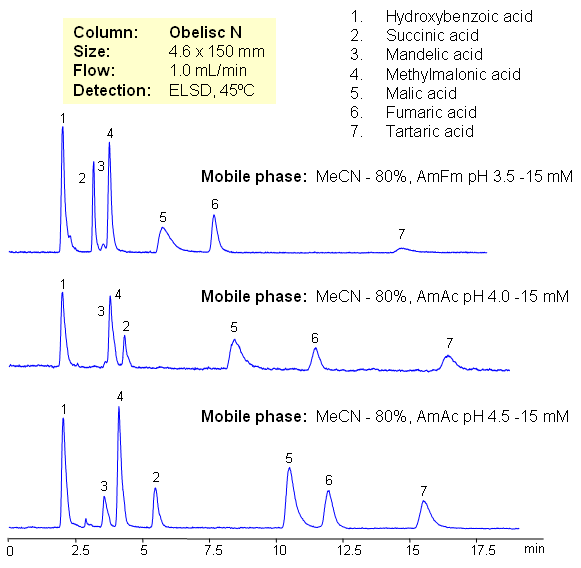
Hydrophilic acids are separated on Obelisc N mixed-mode HILIC column. Seven carboxylic acids are separated based on their polarity and pKa values. Changes in ionization states of acids and stationary phase can be used to control elution order of organic and inorganic acids.
Application Column
Obelisc N
SIELC has developed the Obelisc™ columns, which are mixed-mode and utilize Liquid Separation Cell technology (LiSC™). These cost-effective columns are the first of their kind to be commercially available and can replace multiple HPLC columns, including reversed-phase (RP), AQ-type reversed-phase, polar-embedded group RP columns, normal-phase, cation-exchange, anion-exchange, ion-exclusion, and HILIC (Hydrophilic Interaction Liquid Chromatography) columns. By controlling just three orthogonal method parameters - buffer concentration, buffer pH, and organic modifier concentration - users can adjust the column properties with pinpoint precision to separate complex mixtures.
Select optionsHydroxybenzoic Acid
Malic Acid
Mandelic Acid
Methylmalonic Acid
Organic Acids
Succinic Acid
Tartaric Acid

HPLC Separation of Organic Acids in HILIC Mode on Primesep N Column
December 6, 2007
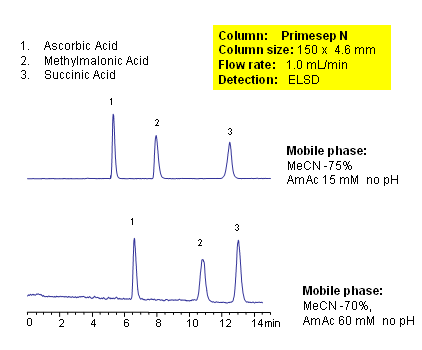
Ascorbic, methylmalonic and succinic are weak organic acids. Retention of these three acids is achieved on Primesep N column in HILIC mode using acetonitrile/water and ammonium acetate. Compounds are monitored by ELSD. Method can be used for determination of ascorbic acid (Vitamin C), methylmalonic acid and succinic acid in various matrices. Other polar organic acids can be analyzed on this HILIC column.
| Column | Primesep N , 4.6×150 mm, 5 µm, 100A |
| Mobile Phase | MeCN/H2O |
| Buffer | AmAc |
| Flow Rate | 1.0 ml/min |
| Detection | ELSD |
| Class of Compounds |
Acid, Vitamin B₆, Hydrophobic, Ionizable |
| Analyzing Compounds | Ascorbic acid (Vitamin C), Methylmalonic acid, Succinic acid |
Application Column
Primesep N
The Primesep family of mixed-mode columns offers a wide variety of stationary phases, boasting unprecedented selectivity in the separation of a broad array of chemical compounds across multiple applications. Corresponding Primesep guard columns, available with all stationary phases, do not require holders. SIELC provides a method development service available to all customers. Inquire about our specially-tailored custom LC-phases for specific separations.
Select optionsMethylmalonic Acid
Organic Acids
Succinic Acid

